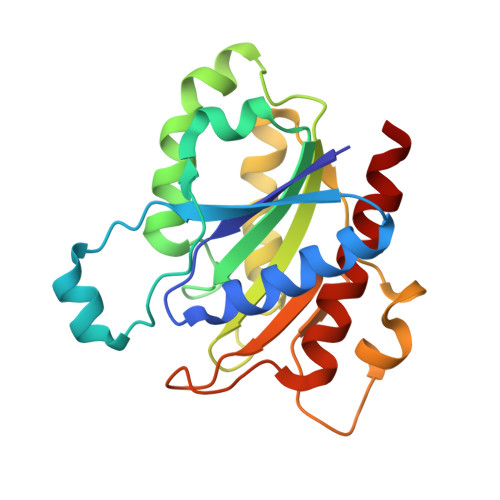Structure, biochemical and kinetic properties of recombinant Pst2p from Saccharomyces cerevisiae, a FMN-dependent NAD(P)H:quinone oxidoreductase.
Koch, K., Hromic, A., Sorokina, M., Strandback, E., Reisinger, M., Gruber, K., Macheroux, P.(2017) Biochim Biophys Acta 1865: 1046-1056
- PubMed: 28499769
- DOI: https://doi.org/10.1016/j.bbapap.2017.05.005
- Primary Citation of Related Structures:
5MP4 - PubMed Abstract:
The genome of the yeast Saccharomyces cerevisiae encodes four flavodoxin-like proteins, namely Lot6p, Pst2p, Rfs1p and Ycp4p. Thus far only Lot6p was characterized in detail demonstrating that the enzyme possesses NAD(P)H:quinone oxidoreductase activity. In the present study, we heterologously expressed PST2 in Escherichia coli and purified the produced protein to conduct a detailed biochemical and structural characterization. Determination of the three-dimensional structure by X-ray crystallography revealed that Pst2p adopts the flavodoxin-like fold and forms tetramers independent of cofactor binding. The lack of electron density for FMN indicated weak binding, which was confirmed by further biochemical analysis yielding a dissociation constant of 20±1μM. The redox potential of FMN bound to Pst2p was determined to -89±3mV and is thus 119mV more positive than that of free FMN indicating that reduced FMN binds ca. five orders of magnitude tighter to Pst2p than oxidized FMN. Due to this rather positive redox potential Pst2p is unable to reduce free FMN or azo dyes as reported for other members of the flavodoxin-like protein family. On the other hand, Pst2p efficiently catalyzes the NAD(P)H dependent two-electron reduction of natural and artificial quinones. The kinetic mechanism follows a ping-pong bi-bi reaction scheme. In vivo experiments with a PST2 knock out and overexpressing strain demonstrated that Pst2p enables yeast cells to cope with quinone-induced damage suggesting a role of the enzyme in managing oxidative stress.
Organizational Affiliation:
Institute of Biochemistry, Graz University of Technology, Petersgasse 12/2, 8010 Graz, Austria.















